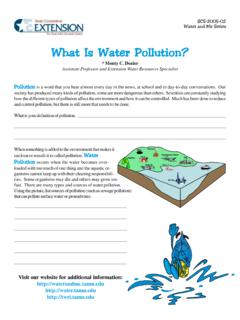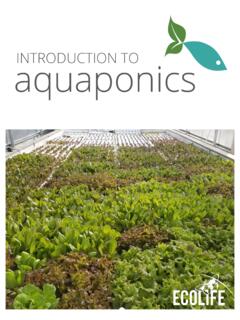Transcription of Protecting Water Quality from Urban Runoff
1 And snowmelt remains above the surface, where it runs off rapidly in unnaturally large sewer systems concentrate Runoff into smooth, straight conduits. This Runoff gathers speed and erosional power as it travels underground. When this Runoff leaves the storm drains and empties into a stream, its excessive volume and power blast out streambanks, damaging streamside vegetation and wiping out aquatic habitat. These increased storm flows carry sediment loads from construction sites and other denuded surfaces and eroded streambanks. They often carry higher Water temperatures from streets, roof tops, and parking lots, which are harmful to the health and reproduction of aquatic life. fromDid you know that because of impervious surfaces like pave-ment and rooftops, a typical city block generates more than 5 times more Runoff than a woodland area of the same size?The most recent National Water Quality Inventory reports that Runoff from urbanized areas is the leading source of Water Quality impairments to surveyed estuaries and the third-largest source of impairments to surveyed lakes.
2 In Urban and suburban areas, much of the land surface is covered by buildings and pavement, which do not allow rain and snowmelt to soak into the ground. Instead, most developed areas rely on storm drains to carry large amounts of Runoff from roofs and paved areas to nearby waterways. The stormwater Runoff carries pollutants such as oil, dirt, chemicals, and lawn fertilizers directly to streams and rivers, where they seriously harm Water Quality . To protect surface Water Quality and groundwater resources, development should be designed and built to minimize increases in Urbanized Areas Affect Water QualityIncreased RunoffThe porous and varied terrain of natural landscapes like forests, wetlands, and grasslands traps rainwater and snowmelt and allows them to filter slowly into the ground. In contrast, impervious (nonporous) surfaces like roads, parking lots, and rooftops prevent rain and snowmelt from infiltrating, or soaking, into the ground.
3 Most of the rainfall The loss of infiltration from urbanization may also cause profound groundwater changes. Although urbanization leads to great increases in flooding during and immediately after wet weather, in many instances it results in lower stream flows during dry weather. Many native fish and other aquatic life cannot survive when these conditions Pollutant LoadsUrbanization increases the variety and amount of pollutants carried into streams, rivers, and lakes. The pollutants include: Sediment Oil, grease, and toxic chemicals from motor vehicles Pesticides and nutrients from lawns and gardens Viruses, bacteria, and nutrients from pet waste and failing septic systems Road salts Heavy metals from roof shingles, motor vehicles, and other sources Thermal pollution from dark impervious surfaces such as streets and rooftopsThese pollutants can harm fish and wildlife populations, kill native vegetation, foul drinking Water supplies, and make recreational areas unsafe and Water Is Everybody s BusinessURBAN RUNOFFEPA 841-F-03-003 Relationship between impervious cover and surface Runoff .
4 Impervious cover in a watershed results in increased surface ruunoff. As little as 10 percent impervious cover in a watershed can result in stream Water QualityManaging Urban RunoffWhat Homeowners Can DoTo decrease polluted Runoff from paved surfaces, households can develop alternatives to areas traditionally covered by impervious surfaces. Porous pavement materials are available for driveways and sidewalks, and native vegetation and mulch can replace high maintenance grass lawns. Homeowners can use fertilizers sparingly and sweep driveways, sidewalks, and roads instead of using a hose. Instead of disposing of yard waste, they can use the materials to start a compost pile. And homeowners can learn to use Integrated Pest Management (IPM) to reduce dependence on harmful addition, households can prevent polluted Runoff by picking up after pets and using, storing, and disposing of chemicals properly.
5 Drivers should check their cars for leaks and recycle their motor oil and antifreeze when these fluids are changed. Drivers can also avoid impacts from car wash Runoff ( , detergents, grime, etc.) by using car wash facilities that do not generate Runoff . Households served by septic systems should have them professionally inspected For More Environmental Protection AgencyNonpoint Source Control Branch (4503T)1200 Pennsylvania Avenue, NWWashington, DC pumped every 3 to 5 years. They should also practice Water conservation measures to extend the life of their septic Impacts from New DevelopmentDevelopers and city planners should attempt to control the volume of Runoff from new development by using low impact development, structural controls, and pollution prevention strategies. Low impact development includes measures that conserve natural areas (particularly sensitive hydrologic areas like riparian buffers and infiltrable soils); reduce development impacts; and reduce site Runoff rates by maximizing surface roughness, infiltration opportunities, and flow Impacts from Existing DevelopmentControlling Runoff from existing Urban areas is often more costly than controlling Runoff from new developments.
6 Economic efficiencies are often realized through approaches that target hot spots of Runoff pollution or have multiple benefits, such as high-efficiency street sweeping (which addresses aesthetics, road safety, and Water Quality ). Urban planners and others responsible for managing Urban and suburban areas can first identify and implement pollution prevention strategies and examine source control opportunities. They should seek out priority pollutant reduction opportunities, then protect natural areas that help control Runoff , and finally begin ecological restoration and retrofit activities to clean up degraded Water bodies. Local governments are encouraged to take lead roles in public education efforts through public signage, storm drain marking, pollution prevention outreach campaigns, and partnerships with citizen groups and businesses. Citizens can help prioritize the clean-up strategies, volunteer to become involved in restoration efforts, and mark storm drains with approved don t dump Your Home into a Stormwater Pollution Solution!
7 Web site links to an EPA homeowner s guide to healthy habits for clean Water that provides tips for better vehicle and garage care, lawn and garden techniques, home improvement, pet care, and Management Measures to Control Nonpoint Source Pollution from Urban technical guidance and reference document is useful to local, state, and tribal managers in implementing management programs for polluted Runoff . Contains information on the best available, economically achievable means of reducing pollution of surface waters and groundwater from Urban Wastewater Treatment System web site contains the latest brochures and other resources from EPA for managing onsite wastewater treatment systems (OWTS) such as conventional septic systems and alternative decentralized systems. These resources provide basic information to help individual homeowners, as well as detailed, up-to-date technical guidance of interest to local and state health Impact Development center provides information on Protecting the environment and Water resources through integrated site design techniques that are intended to replicate preexisting hydrologic site Manager s Resource Center (SMRC) and maintained by the Center for Watershed Protection, this resource center is designed specifically for stormwater practitioners, local government officials, and others that need technical assistance on stormwater management : Community Responses to Runoff Natural Resources Defense Council developed this inter-active web document to explore some of the most effective strategies that communities are using around the nation to control Urban Runoff pollution.
8 The document is also available in print form and as an interactive 2003 Related Publications

















